Meet Stella
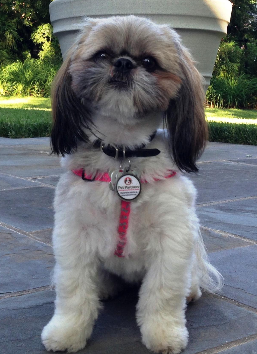
Arlington, VA by Lorraine Wodiska
Meet Stella
In the past decade, I began studying neurobiology and was surprised with how well it fits with what I was learning about canine-assisted psychotherapy. Stella (a ten-pound Shih-Tzu), has been in all individual, couples, and group therapy sessions. Although you will see her in some sessions, she feels free about taking off some time from this demanding work.
TYPES OF DOGS
Most people are familiar with Service Dogs—those dogs who have trained behaviors that specifically help their handler who has a disability; for example, being “eyes” for a blind person or “ears” for someone who is deaf. These animals have federal recognition and protection under the law and are permitted in places where dogs are generally not allowed to enter. There are also Working Dogs who assist at the airport in sniffing for drugs or helping the fire department or the police department. And, now there are an ever-increasing number of Emotional Support Dogs, who keep an individual owner emotionally grounded.
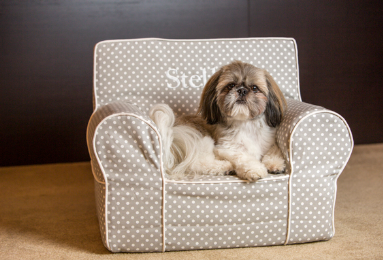
Arlington, VA by Lorraine Wodiska

Arlington, VA by Lorraine Wodiska
A THERAPY DOG
A Therapy Dog helps people primarily in emotional ways and works with many individuals. These dogs are often taken by their owner or handler to a healthcare facility to make visits to patients for a couple of hours a day, perhaps once or twice a week. This has become more common in the past several years and there are dogs available in hospitals, schools at all levels (including universities), and prisons. Therapy dogs are also brought to sites to comfort first responders and those impacted by a natural disaster or by a tragic situation.
A PROFESSIONAL THERAPY DOG
There are a very small number of Professional Therapy Dogs and there are no standards or ethics delineated in the mental health field for these remarkable animals with unique roles. Professionals in the field of animal ethology and behaviorists have made important strides in establishing guidelines for the safety of the dogs working in the previously mentioned venues.
In the past, as a Professional Therapy Dog, Stella stayed in my office and engaged with people who came for psychotherapy. Therapy dogs have a stressful job, needing to interact with many people every day: each with a different personality and each with a different way of engaging with her. She worked for several hours (with breaks of course) and experienced the expression of intense emotion as a part of a typical day. She was calm, friendly, able to manage strong emotions, and attentive to the mood in the room. Now that she is senior, she has mostly retired, although she may greet you at the door and sit in the consulting room with us.
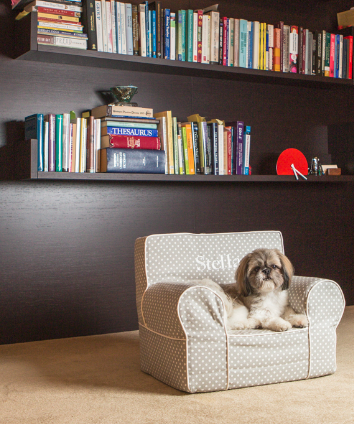
Arlington, VA by Lorraine Wodiska
HOW DID STELLA BECOME A PROFESSIONAL THERAPY DOG?

Arlington, VA by Lorraine Wodiska
She was a spunky and active pup and fortunately had the temperament to become a Professional Therapy Dog and we began to learn what was involved in our new professional endeavor.
There are ethics to consider when we are working together: for you, for me as the therapist, for Stella, and for us as a team. Therefore, this is not the same as a therapist “bringing a dog to work” but involves knowledge about ethics, about canine behavior in general, and about what is happening within each of us when she is involved. Stella and I have offered local and national workshops to mental health professionals on how to work with Canine Assisted Psychotherapy in an ethical and competent manner. I have begun working with a colleague to form an organization, SCAPE (Society for Canine Assisted Psychotherapy Excellence) to create standards and guidelines for this work.
WHAT HAPPENS DURING SESSIONS?

At this time she comes into all individual, couples and group sessions. She is very friendly and enjoys being with people. She may greet you at the door and may escort you to the exit at the end of the session. Sometimes she will sense a mood or feeling and walk over to you to be available to be petted during our appointment. She may respond to you in other ways as well, including bringing you a toy or vocalizing to ask permission to play or requesting to sit on the seat near you. She has her leash on at all times and this is how she knows she is “at work”. Although she is attentive to the affect in each session, Stella will sometimes respond by moving towards you, sometimes moving to another place in the room and sometimes staying put in her place.
Although she will most often sit/lie quietly throughout our time together she creates a unique relationship with each person. Some people have petted her throughout a session, some have told their most difficult stories to her while I listen. Some have taught her tricks and some have picked her up when they needed physical contact. Some sit on the floor and play with her while we are talking, and some leave her completely alone.
Within couples’ sessions, she may respond to struggles between partners by going over to one or the other member or by sitting between them. One or the other in the couple may pick her up, talk to her or engage her in play. These interactions frequently bring forward information about the individual and their relational dynamics within the couple and parenting styles.
In group therapy, she has a chair in the circle and often sits there. However, on many occasions she will get up and change her seat or position. Sometimes she will sit at someone’s feet and sometimes she will ask someone to play. She may sit in the middle of the group, in her chair or at the door when she has had enough of group therapy. Again, members respond to her as well: looking to her for comfort or understanding, making interpretations about her behavior towards themselves or others, or being reminded about experiences with their parents, siblings and partners.
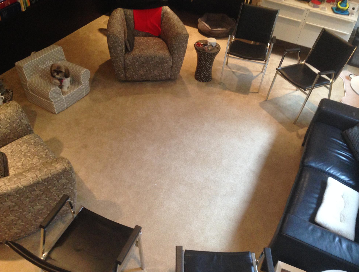
Arlington, VA by Lorraine Wodiska
WHY DO I HAVE A DOG IN THE PSYCHOTHERAPY SESSION?
The answer brings in my interest in Interpersonal Neurobiology (IPNB), particularly related to the human-animal bond. The American Veterinary Medical Association’s Committee on the Human Animal Bond (HAB) defines it as a mutually beneficial and dynamic relationship between people and other animals that is influenced by behaviors that are essential to the health and well-being of both. This includes, but is not limited to emotional, psychological, and physical interactions with people, other animals, and the environment. We understand more about how this bond works by considering the brain and very basic neuroscience; and, fortunately, information about these topics has become more available to practitioners in the past decade.
WHAT IS INTERPERSONAL NEUROBIOLOGY (IPNB)?
We experience relationships from the time we are born and our brains are shaped by these very early interactions and continue to be shaped by all relationships throughout our lifetime, particularly with our intimates. “Interpersonal” indicates engagement with one or more people. “Neurobiology” indicates changes in our hormones and neural circuitry. With each interaction, we are rewiring our brain or we are deepening the wiring we acquired when we were younger.
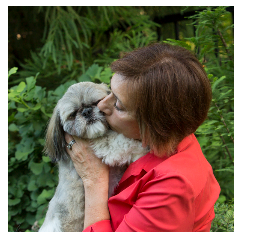
Arlington, VA by Lorraine Wodiska
HOW IS THE BRAIN INVOLVED?
The brain is wonderfully malleable and every positive interaction we have with caring, loving others (including dogs) changes our brain. Surprisingly, the brain is a relational structure: it assists us in determining how to behave in an interpersonal situation. A major function of our brain is to process information in order to connect us to (or avoid) other people. In the best case, your brain first determines that the situation and the other person are safe and that you can begin to think; or, to let down your guard to engage in a more genuine and open manner in the moment. Because Stella will likely greet you and the door and wag her tail, this frequently sets up a situation of safety, friendliness, and readiness to address psychological issues in the session that may be stressful or challenging. It is interesting to consider that Stella also has a mammalian brain, although her cortex is far smaller of course! She has emotional reactions and responses to each person and situation, going through a similar assessment process as you and this is part of the unique relationship she will create with you.
STELLA’S TRICKS
Stella’s tricks are performed to create an enjoyable interaction with you. Although these tricks will likely impact your brain, your mood and your choices within a session, most of these consequences and decisions will happen so quickly that it will not seem that you thought about it at all. Stella has quite a “trick book” including: closing the door when you enter, giving you a high five, taking a tissue from a box and giving it to you, retrieving something that has fallen to the floor, giving you my card for the next appointment and taking a bow.
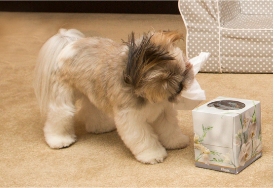
Arlington, VA by Lorraine Wodiska
STELLA’S "PROFESSIONAL CREDITS"

Arlington, VA by Lorraine Wodiska
She is a Distinguished Therapy Dog, recognized by the American Kennel Club as having improved the lives of those with whom she has interacted. She has earned her Advanced Trick Dog title.
With me, Stella has presented at a number of local, regional and national organizations, “Therapy is Going to the Dogs” which describes the training, psychotherapeutic benefits, and challenges, positive neurobiological impact, and ethics for the dog, the therapist, and the patient.
QUESTIONS
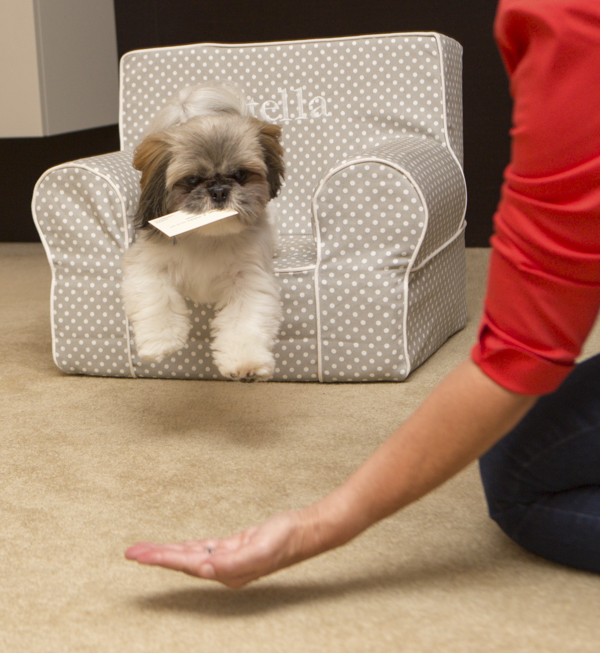
Arlington, VA by Lorraine Wodiska
